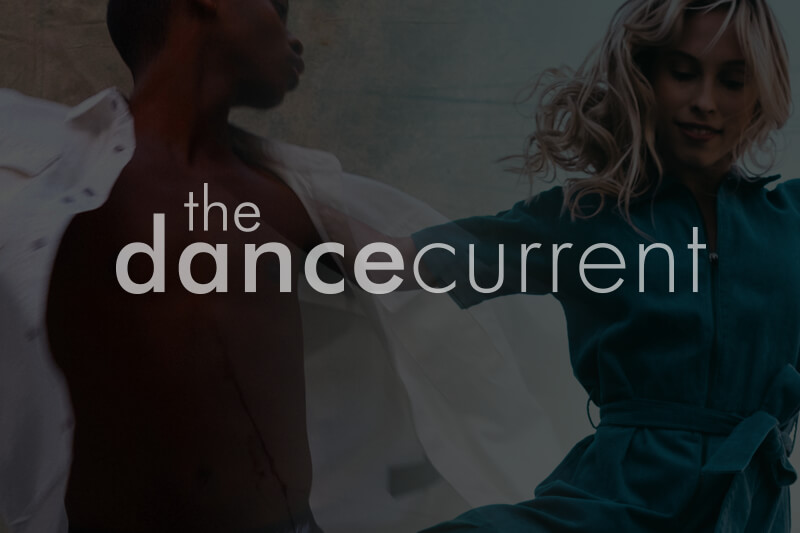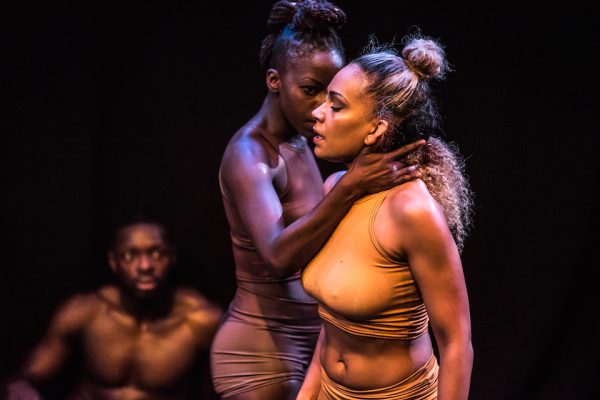In dance, as in all aspects of life, diversity is truly something to be sought out, encouraged and celebrated. In its tenth year, the CanAsian International Dance Festival does more than recognize the multiculturalism of Canadian dance; it reveres the place of tradition in dance. The importance of preserving traditional dances for their own sake is unquestionable, but under the directorship of Denise Fujiwara, the festival reaches further — into the heritage of humanity. Thickly woven into each gesture and step of traditional dance are the fables, folklore and rituals that cement the cornerstones of cultural identity. But dance is an organic creature and cannot be trapped by the past. The artists in this year’s festival infused their dances with the sentiments of their own relationship to cultural tradition; some holding it closer than others, some railing against its constraints.
Programme A opened with InDance performing “Uma”, in the irresistibly hypnotic bharatanatyam style of southern India. Recalling the mystique of a devadasi temple, the veiled dancer Sudarshan Belsare leads the musicians on a slow promenade, with each carefully placed footstep accompanied by the purl of soft, brassy bells laced onto the cuffs of his costume. Belsare, an inspired talent in stri-vestam, the art of female impersonation, plays with incarnations of the feminine, from virgin to temptress, but it is, without question, his mastery of bharatanatyam that has wooed audiences — and has “Uma” returning to the festival for a second time, due to popular demand. Belsare, at full tilt, is as mesmerizing as staring into the heart of a fire. The rapidly changing, intricate finger positions blur like a halo of sparks, as his arms windmill in full circles. Daring geometric shapes define the beginnings and ends of phrases, which blend into magnetic sequences that traverse the floor in diamond patterns. Jolting words spoken by one of the singers breaks the billowing music: “Hey you, bitch. You’ve stolen my man”. Gesturing to the musicians for empathy, Belsare smoulders as the vengeful woman. Balanced in a deep, dramatic knee bend, kohl-swept eyes gleaming with envy, this temptress never loses her gem-like lustre, and exudes the confidence of one who conquers all she desires.
Standing in diametric contrast to bharatanatyam is the odissi form, lyrical and graceful and styled after the element of water. Chitralekha Odissi Dance Creations, comprised of the talented Patnaik family, specialize in this revived ancient dance, and presented a new work, “Kedar Pallavi”, at the conclusion of program B. Devraj Patnaik, a prolific odissi choreographer and rightly-reputed prodigy of odissi dance, takes choreographic credit for this splendid Pallavi — indulgently meaningless, melodious and delightful. The sibling duo Ellora and Devraj Patnaik complemented each other in fluid phrases. Ellora, showing off the charms of femininity with blossom-soft gestures and sophisticated co-ordination of the tribhangi, is slightly more efficient than her brother, whose puckish inclinations of the head and gently expressive arms make plain his infatuation with the dance. The purity of this Pallavi, enlivened by Devraj’s inventiveness and danced with vivacity, left me gently invigorated.
The works cushioned between these more traditional Indian dances resonated with personal experience in confronting the tenets of tradition. As the nomenclature indicates, “Mind’s Hammer”, created and danced by Peter Chin of Tribal Crackling Wind, focuses on the deconstruction of rational precepts. The choice of collaborator, Evergreen Club Contemporary Gamelan, reflects the schema of structure running through the piece. Gamelan, a traditionally Indonesian genre, refers more to the set of metallic and wood instruments built specifically for one ensemble than to the musicians who play them. At first, Chin dances in broad, earthy sweeps around the great raft of instruments in a harmonic, complementary relationship with them. This is succeeded by a shifting syntactic relationship to the music as Cartesian concepts of harmony begin to fall. The erratic oscillation between refined eurhythmic harmony and chaotic freewheeling creates a sense of deep mistrust between dancer and music, and is ultimately fragmentary. The best moments of the piece strike, curiously, both when Chin is with the gamelan, and when he is vehemently against. At one moment, Chin’s body reverberates with the deep toll of a bell as if it originated from his stomach, with his convulsing limbs akimbo and head thrown back in vehement disregard of rhythm. The gamelan collects in a riveting final movement with a cascade of full-steam-ahead hammering, but by this point Chin — though dancing as deftly as a leaf in the wind — had exhausted his movement vocabulary.
Occasionally, it is the guileless honesty of a piece that is heartrending beyond idea or execution. Wen Wei Wang, artistic director of Wen Wei Dance, possesses the rare and compelling quality of transparency that does much for this dance, inspired from a formative childhood moment. The multimedia design of “One Man’s…” complements the kaleidoscopic nature of emotion, with elements of film, narrative storytelling and dance. The film begins and subsides in a flourish of enhanced images of repeated movements, and contrasts with the peaceful figure of Wang sitting cross-legged on the floor. Wang’s gentle narration of a tender childhood story leaves no secrets about the dance to follow but it is enjoyable for the bittersweet tale of survival it tells. Elements of the choreography — minute stabbing steps after the image of a chicken come to mind — are endearing more for this reason than for their originality. The truths contained in his dance transcend Wang’s own story, and express a kind of quintessence of humanity.
The highlight of the festival, for this writer, was Soojung Kwon’s “Choonengmu”, for its simple juxtaposition of classical and contemporary dances, which illuminated both the beauty and poignancy of changing feminine experience over time. Soojung Kwon, gracing the festival for the second year successively, is an artist growing in reputation for her daring yet elegant contemporary reinventions of Korean classical court dance. Working in close collaboration with Jihee Son, a master of classical court dance, Kwon challenges the traditional constructs of femininity by expanding upon classical gesture and informing it with the freedom of her own heart.
Jihee Son appears, austere in elaborate traditional court garb with scarves trailing from wrists over hands, her breath alone a dance. Barely moving, she fills each gesture with mesmerizing solemnity and sorrow. Her dance escalates to a single, momentous promenade of boundless grace. Then, in the thin light of upstage, a girl in simpler dress begins to dance, mirroring Son’s wafting arms but with a youthful ease of movement. Soon, like a bird let free from a cage, Kwon flies, dancing the canons of her traditional dance to the edge of their life with lyrical expression. As traditional instruments render a classical melody with romantic swell, Kwon waltzes large circles around Son, the maypole of classicism.
Butoh theatre is rarely an easy experience, with its typically grotesque body transformations and absurd or macabre metaphors. The butoh theatre of Natsu Nakajima — original student of and performer with founding butoh artists the late Tatsu Hijikata and Kazuo Ohno — is decidedly poetic. “Sumida River”, her interpretation of the fifteenth-century Japanese Noh play “Sumidagawa” for Denise Fujiwara (also the festival’s artistic director) is a tragic rendering in excess of butoh. A legendary tale in Japan that needs only a few props to recall the story, it is the tragedy of a mother’s descent into madness after the death of her child. A chorus of jungle noises, characteristic of the eclectic musical design of butoh, heralds the action. Fujiwara is already transfigured by grief, symbolized by a soiled yellow sheet. In the cyclical outlook of butoh, death sparks the action. Fujiwara dances imagery belonging to the nightmare realm, yet somehow she remains entirely human and pitiable. Her teetering balances are horrifying, as if she’s tearing her soul to escape herself. Pitching from guileless poignancy to cataclysmic grief, she suggests the love of mother and child by holding hands with the corner of her hat while walking alongside it on the diagonal. Recollections of childish play collapse into torturous dreams, and her face contorts into an arresting silent scream. The fatalistic boat journey is the lynchpin of the tragedy. Here Fujiwara drags the boat in heaving lunges in epic metaphor, eclipsed by darkness. Two ringing bells, echoing the mother and child calling to one another, haunt the blackness. Rigorous applause fades. People remain in their seats for a long time.
This anniversary festival was a spectacle for the masses. With the meaning of culture and tradition at its heart, it tapped essences of this diverse city. Although disappointingly under-attended for a festival featuring highly renowned dancers, on more than one occasion, it both inspired and stole the breath from us in unison.
Tagged: Asian, Festival, Performance, ON , Toronto




